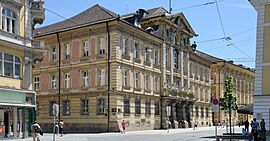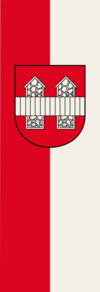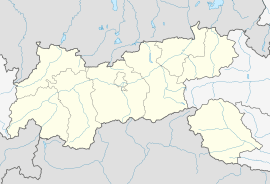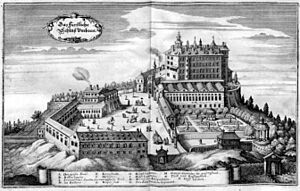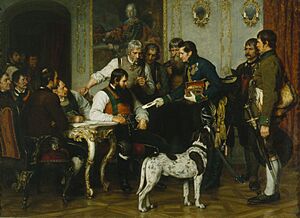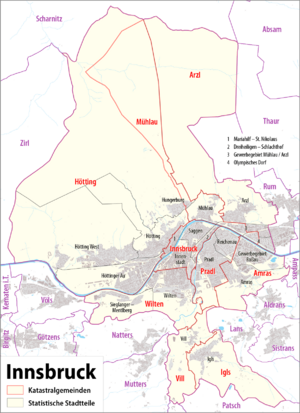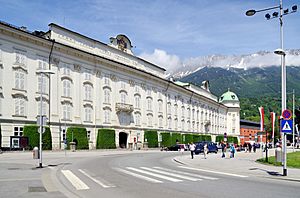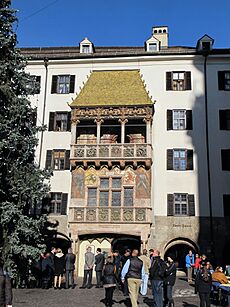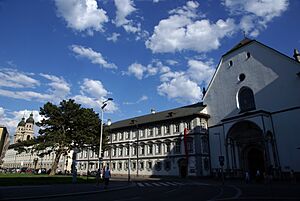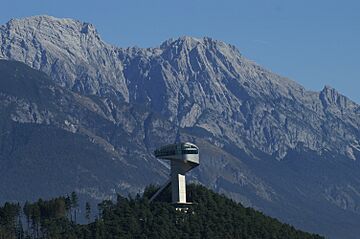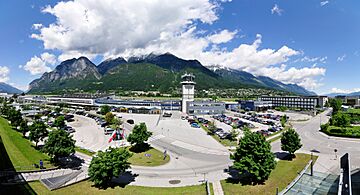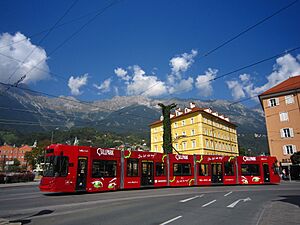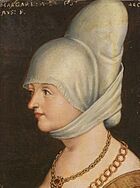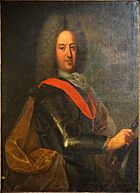Innsbruck facts for kids
Quick facts for kids
Innsbruck
Innschbruck (Bavarian)
|
|||
|---|---|---|---|
|
From top, left to right: Bürgerstraße, Conradstraße, view of Innsbruck, St. Anne's Column in Maria-Theresien-Straße, Stift Wilten, Ambras Castle, Altes Landhaus
|
|||
|
|||
| Country | Austria | ||
| Federal state | Tyrol | ||
| District | Statutory city | ||
| Area | |||
| • Statutory city | 104.91 km2 (40.51 sq mi) | ||
| Elevation | 574 m (1,883 ft) | ||
| Population
(2018-01-01)
|
|||
| • Statutory city | 132,493 | ||
| • Density | 1,262.92/km2 (3,270.95/sq mi) | ||
| • Metro | 228,583 | ||
| Demonym(s) | Innsbrucker (m.) Innsbruckerin (f.) (de) |
||
| Time zone | UTC+1 (CET) | ||
| • Summer (DST) | UTC+2 (CEST) | ||
| Postal code |
6010–6080
|
||
| Area code | 0512 | ||
| Vehicle registration | I | ||
| Website | innsbruck.at | ||
Innsbruck (pronounced INNS-brook) is the capital city of Tyrol in Austria. It is the fifth-largest city in the country. The city sits on the River Inn, where it meets the Wipp Valley. This valley leads to the Brenner Pass, which is about 30 kilometers (19 miles) to the south. In 2018, Innsbruck had a population of 132,493 people.
The city is located in a wide valley surrounded by tall mountains. To the north are the Karwendel Alps, with peaks like Hafelekarspitze (2,334 meters or 7,657 feet). To the south are Patscherkofel (2,246 meters or 7,369 feet) and Serles (2,718 meters or 8,917 feet). Innsbruck is famous as a winter sports center. It hosted the 1964 Winter Olympics and 1976 Winter Olympics. It also hosted the first 2012 Winter Youth Olympics in 2012. The name "Innsbruck" means "bridge over the Inn River."
Contents
History of Innsbruck
Ancient Beginnings
The first signs of people living here date back to the early Stone Age. Old place names from before the Romans show that people have lived here continuously. In the 4th century, the Romans built a military base called Veldidena. This base protected an important trade route that went from Verona to Augsburg, crossing the Brenner Pass.
Innsbruck was first mentioned as Oeni Pontum or Oeni Pons. This is Latin for "bridge over the Inn River." The bridge was a very important crossing point. In 1180, the Counts of Andechs took control of the town. Later, in 1248, the town became part of the County of Tyrol. The city's coat of arms, used since 1267, shows a view of the Inn bridge from above. The route over the Brenner Pass was a major link between northern and southern Europe. It was the easiest way to cross the Alps. This route helped the city become rich and successful.
Early City Life

In 1429, Innsbruck became the capital of all Tyrol. In the 15th century, it grew into a major center for European politics and culture. Emperor Maximilian I lived in Innsbruck in the 1490s. His presence helped the city a lot. For example, the Hofkirche (Court Church) was built. A funeral monument for Maximilian was planned there. This monument, with its cenotaph and bronze statues of his ancestors, is a key artwork in Innsbruck. In 1490, a regular postal service started between Innsbruck and Mechelen.
In 1564, Ferdinand II, Archduke of Austria became the ruler of Tyrol. He also managed other Austrian lands from Innsbruck until the 18th century. He built Schloss Ambras (Ambras Castle). There, he kept his amazing Renaissance collections. Today, most of these are in Vienna's Kunsthistorisches Museum. Until 1665, a branch of the Habsburg family ruled Innsbruck with their own court. In the 1620s, the first opera house north of the Alps was built in Innsbruck.
The University of Innsbruck was founded in 1669. This happened after the Habsburg family's Tyrolean branch ended in 1665. Emperor Leopold I then ruled from Vienna.
During the Napoleonic Wars, Tyrol was given to Bavaria, which was an ally of France. Andreas Hofer led a Tyrolean peasant army to victory in the Battles of Bergisel. They fought against the combined Bavarian and French forces. Hofer then made Innsbruck the center of his government. Later, the combined army defeated the Tyrolean army. Innsbruck was part of Bavaria until 1814. After the Vienna Congress, Austrian rule returned. Andreas Hofer was executed in Mantua. His body was brought back to Innsbruck in 1823 and buried in the Franciscan church.
In 1848, riots in Vienna caused Emperor Ferdinand to move the government to Innsbruck for a short time. During World War I, Allied planes raided Innsbruck in 1918. This caused some injuries to Austrian troops. After the war, Italian soldiers occupied Innsbruck and Tyrol. In 1929, Innsbruck hosted the first official Austrian Chess Championship.
Modern History
In 1938, Nazi Germany took over Austria in an event called the Anschluss. During World War II, Innsbruck had two subcamps of the Dachau concentration camp. One camp held important people from 16 countries and their families as hostages. These included former French Prime Minister Léon Blum and former Austrian Chancellor Kurt Schuschnigg. From 1943 to 1945, Innsbruck was bombed 22 times and suffered heavy damage.
In 1996, the European Union approved closer ties between Austrian Tyrol and the Italian provinces of South Tyrol and Trentino. This led to the creation of the Euroregion Tyrol-South Tyrol-Trentino.
Geography and Climate
Weather in Innsbruck
Innsbruck has a humid continental climate. This means it has big temperature changes between seasons. Winters are often very cold and snowy. However, a warm wind called the foehn wind can sometimes cause thaws.
Spring is short. Days become warm, often over 15°C (59°F), but nights stay cool or even freezing. Summer weather can change a lot. Days might be cool and rainy, or sunny and very hot, sometimes reaching 34°C (93°F). In summer, nights usually stay cool, around 12°C (54°F) on average. The average yearly temperature in Innsbruck is 9°C (48°F).
City Areas
Innsbruck is divided into nine main areas called boroughs. These were once separate towns or villages. These boroughs are then split into twenty smaller sections called wards. For counting purposes, Innsbruck is further divided into 42 statistical units.
Here are the nine boroughs with their populations from 2011:
- Innsbruck (inner city) (18,524 people)
- Wilten (15,772 people)
- Pradl (30,890 people)
- Hötting (31,246 people)
- Mühlau (4,750 people)
- Amras (5,403 people)
- Arzl (10,293 people)
- Vill (535 people)
- Igls (2,204 people)
Places to Visit in Innsbruck
Famous Mountains
- Nordkette
- Patscherkofel
Buildings and Monuments
- Old Inn Bridge (Alte Innbrücke)
- Ambras Castle
- Andreas Hofer's tomb
- St. Anne's Column (Annasäule)
- Bergisel Ski Jump
- Golden Roof (Goldenes Dachl)
- Helbling House (Helblinghaus)
- Imperial Palace (Hofburg)
- Hungerburgbahn
- Leopold Fountain (Leopoldsbrunnen)
- Maria-Theresien-Straße
- Maximilian's Cenotaph and the Black Men (Schwarzen Männer)
- Old Town (Altstadt)
- City Tower (Stadtturm)
- Triumphal Arch (Triumphpforte)
Museums to Explore
- Alpine Club Museum
- Ambras Castle
- Armoury
- Grassmayr Bell Foundry and Museum
- Tyrol Panorama Museum (Das Tirol Panorama)
- Tyrolean Folk Art Museum (Tiroler Volkunstmuseum)
- Tyrolean State Museum (Tiroler Landesmuseum or Ferdinandeum)
Important Churches
- Court Church (Hofkirche)
- Innsbruck Cathedral (Dom zu St. Jakob)
- Jesuit Church
- Wilten Abbey (Stift Wilten)
- Wilten Basilica (Wiltener Basilika)
Parks and Gardens
- Alpine Zoo (Alpenzoo)
- Innsbruck University Botanic Garden
- Hofgarten (Court Garden)
- Ambras Castle Park (Schlosspark Ambras)
Culture and Events
Fun Cultural Events
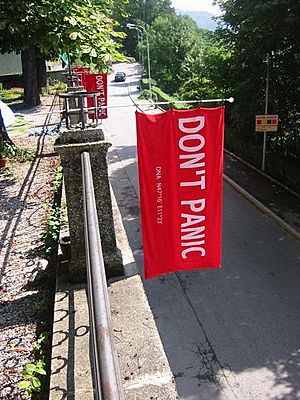
Innsbruck is a very popular place for tourists. It hosts many events each year:
- Innsbrucker Tanzsommer (Dance Summer)
- Bergsilvester (New Year's Eve)
- Innsbruck Festival of Early Music
- Christkindlmarkt (Christmas fair)
In 1971, the author Douglas Adams got the idea for his famous The Hitchhiker's Guide to the Galaxy series while visiting Innsbruck. Because of this, Towel Day is celebrated worldwide on May 25th every year.
Sports in Innsbruck
Innsbruck is surrounded by high mountains, making it perfect for skiing in winter. In summer, it's great for ski-jumping and mountaineering. There are several ski resorts nearby. The Nordkette is reached by a cable car. Other resorts include Axamer Lizum and Patscherkofel. You can even ski in summer in the Stubai Valley because of its glaciers.
Innsbruck has hosted the Winter Olympic Games twice. First in 1964, then again in 1976. It also hosted the 1984 Winter Paralympics and 1988 Winter Paralympics. In 2012, Innsbruck hosted the first 2012 Winter Youth Olympics.
Other big sports events held here include the Air & Style Snowboard Contest. The city's Bergiselschanze is one of the famous hills in the Four Hills Tournament for ski jumping. Innsbruck is home to football clubs WSG Tirol and FC Wacker Innsbruck. Their stadium, Tivoli Neu, was one of the venues for Euro 2008. The city also hosted games for the 2011 IFAF World Championship in American Football. In 2018, Innsbruck hosted the IFSC Climbing World Championships. It also hosted the 2018 UCI Road World Championships for cycling.
Language Spoken
Innsbruck is in a region where the Austro-Bavarian dialect is spoken. More specifically, people speak Southern Bavarian. However, young people in Innsbruck are starting to use more Standard German.
Economy and Transport
How Innsbruck Makes Money
Innsbruck is a big tourist center. Over a million people stay overnight in the city each year. There are many jobs in Innsbruck, with about 86,186 employees. Around 35,000 people travel into Innsbruck for work every day from nearby towns. In 2012, the unemployment rate was 4.2%.
The city's economy is strong. In 2013, the GDP per person in the Innsbruck region was €41,400. This is about 60% higher than the average for the European Union. Big companies like Tiroler Wasserkraft (energy) and MED-EL (medical devices) have their main offices in Innsbruck. Housing in Innsbruck is quite expensive. The average price for a square meter was €4,430 in 2015.
Getting Around Innsbruck
Innsbruck is on the A12/A13 highway system. This connects it to Verona, Italy, and Munich, Germany. Innsbruck Hauptbahnhof is the main train station. It is one of the busiest in Austria. It connects Innsbruck to Germany, eastern Austria, western Austria, and northern Italy.
Innsbruck Airport is located west of the city. It has flights to major cities like Frankfurt, London, and Vienna. During winter, many skiers fly into Innsbruck. The airport is about 4 kilometers (2.5 miles) from the city center.
Public transport in Innsbruck is run by Innsbrucker Verkehrsbetriebe (IVB). They operate a network of buses and trams. There are four city tram lines and two lines that go to nearby areas. The tram network is planned to grow in the future. Many bus lines serve the city and connect it to surrounding areas.
In 2007, the Hungerburgbahn funicular reopened. This funicular goes to the Hungerburg district. It was rebuilt with new vehicles and a new path under the Inn River. The stations were designed by the famous architect Zaha Hadid. They are now a new symbol of the city.
Education and Organizations
Learning in Innsbruck
Innsbruck is a university city with several colleges and universities. The oldest grammar school in Western Austria is the "Akademisches Gymnasium Innsbruck". It was founded in 1562 by the Jesuit order. This school was the start of the University of Innsbruck, which opened in 1669.
Other important universities include the Innsbruck Medical University and the MCI Management Center Innsbruck. The Medical University has one of Europe's best clinics for ski injuries.
Important Organizations
- The main office for SOS Children's Villages is in Innsbruck. This is one of the world's largest charities.
- The international organization Austrian Service Abroad was founded in Innsbruck in 1992. It helps young Austrians do community service in other countries.
- MED-EL, a big company that makes cochlear implants, has its main office in Innsbruck.
- The Aouda.X space suit simulator is being developed in Innsbruck. This is used for Mars analogue missions.
Famous People from Innsbruck
Royalty and Nobles
- Frederick III, Holy Roman Emperor (1415–1493), the first Holy Roman Emperor from the House of Habsburg.
- Margaret of Austria, Electress of Saxony (around 1416–1486), a princess from the House of Habsburg.
- Sigismund, Archduke of Austria (1427–1496), a Habsburg archduke and ruler of Tyrol.
- Anna of Tyrol (1585–1618), an Archduchess of Austria and later Holy Roman Empress.
- Leopold, Duke of Lorraine (1679–1729), known as "the Good," was Duke of Lorraine.
Public Figures
- Eusebio Kino (1645–1711), a Jesuit missionary and explorer.
- Josef Speckbacher (1767–1820), a leader in the Tyrolean rebellion against Napoleon.
- Diana Budisavljević (1891–1978), a humanitarian who helped many people during World War II.
- Karl Gruber (1909–1995), an Austrian politician and diplomat.
- Christian Schwarz-Schilling (born 1930), a German politician and businessman.
- Andreas Maislinger (born 1955), an Austrian historian and founder of the Austrian Holocaust Memorial Service.
Artists and Performers
- Jacob Regnart (1540s–1599), a Flemish Renaissance composer.
- Clemens Holzmeister (1886–1983), a famous architect and stage designer.
- Erwin Faber (1891–1989), an actor who performed in Munich.
- William Berger (1928–1993), an Austrian-American actor.
- Eva Lind (born 1966), a well-known opera singer.
- Alice Tumler (born 1978), a television presenter.
- Nathan Trent (born 1992), a singer who represented Austria in the Eurovision Song Contest 2017.
Scientists and Thinkers
- Adam Tanner (1572–1632), a Jesuit professor and mathematician.
- Wilibald Swibert Joseph Gottlieb von Besser (1784–1842), an Austrian-born botanist.
- Georg Luger (1849–1923), the Austrian designer of the famous Luger pistol.
- Peter Zoller (born 1952), a theoretical physicist and professor at the University of Innsbruck.
- Veronika Sexl (born 1966), a pharmacologist and toxicologist, now rector of the University of Innsbruck.
Sports Stars
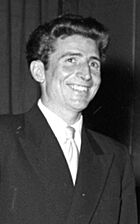
- Roderich Menzel (1907–1987), a tennis player and author.
- Hermann Buhl (1924–1957), a mountaineer considered one of the best climbers ever.
- Dagmar Rom (born 1928), a former alpine ski racer who won two gold medals.
- Markus Prock (born 1964), a luger who competed in many events.
- Barbara Schett (born 1976), an Austrian tennis player and sportscaster.
- Gregor Schlierenzauer (born 1994), a ski jumper with the most World Cup victories.
- Vanessa Herzog (born 1995), a speed skater.
International Connections
Sister Cities
Innsbruck has sister city relationships with several cities around the world:
 Freiburg im Breisgau, Germany (since 1963)
Freiburg im Breisgau, Germany (since 1963) Grenoble, France (since 1963)
Grenoble, France (since 1963) Sarajevo, Bosnia and Herzegovina (since 1980)
Sarajevo, Bosnia and Herzegovina (since 1980) Aalborg, Denmark (since 1982)
Aalborg, Denmark (since 1982) Tbilisi, Georgia (since 1982)
Tbilisi, Georgia (since 1982) Ōmachi, Japan (since 1985)
Ōmachi, Japan (since 1985) New Orleans, United States (since 1995)
New Orleans, United States (since 1995)
Partnerships
 Kraków, Poland (since 1998)
Kraków, Poland (since 1998)
Austrian Service Abroad
The Austrian Service Abroad is a non-profit group based in Innsbruck. It offers young Austrians a chance to do national service in other countries. They work in areas like remembering the Holocaust, social service, and peace service. It was founded in 1998 by Andreas Maislinger and Andreas Hörtnagl.
Images for kids
See also
 In Spanish: Innsbruck para niños
In Spanish: Innsbruck para niños








